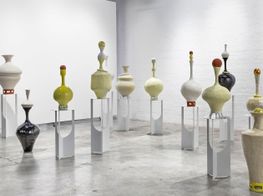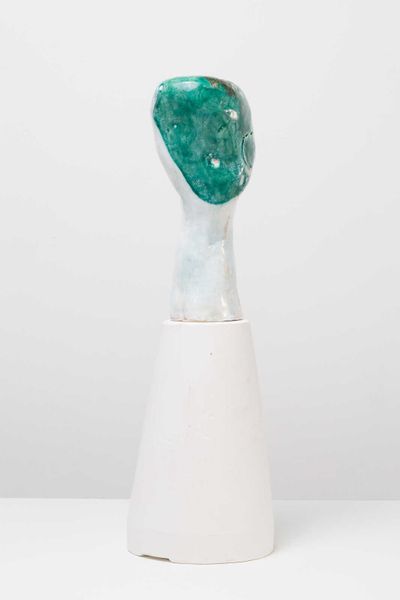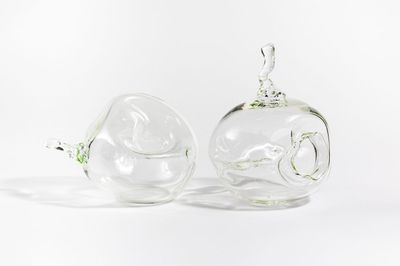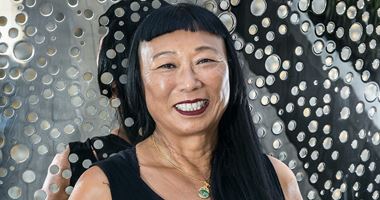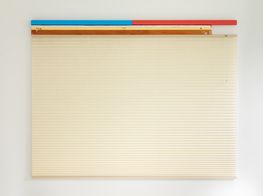Spring1883 in Melbourne: Artist Highlights
With Melbourne under lockdown, Spring1883 art fair returns for its seventh edition with an online programme featuring 29 galleries from Australia and New Zealand. Explore some of the artist highlights on view, from 4 to 29 August 2021, in this editorial selection.
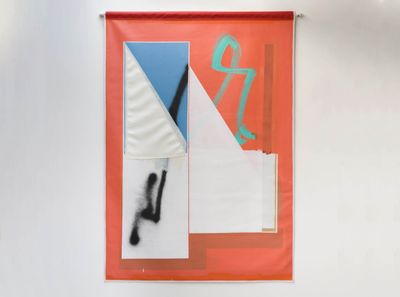
Ed Bats, Beware the wedge (2021). Acrylic, aerosol vinyl on canvas, 171 × 120cm. Courtesy Gallery 9, Sydney.
Ed Bats at Gallery 9
Cape Town-born and Wellington-based artist Ed Bats creates abstract compositions that invoke hard-edge painting and abstract expressionism. An architectural quality pervades these painted works, whether in the use of found objects such as Venetian blinds or rigid lines and blocks of colour.
Bats is showing three recent paintings with Gallery 9 at Spring1883, all completed in 2021. Beware the wedge shows opaque planes of white overlaid on blue and salmon orange, with strokes of black and green aerosol paint adding a sense of movement to the otherwise static composition. Underneath all this lies a faint suggestion of colour blocking, resembling a graffiti wall that has been painted over—perhaps an echo of Bats' earlier graffiti interventions across Europe and Aotearoa New Zealand.
Writing in 2017, Bats described music as 'an integral part to my artmaking' that 'serves as a form of escapism.' The variously elongated forms in The Nightwatchman and Turbo Island stack together or behind another, lending a lyrical quality to the canvases.
Madeleine Preston at Blackartprojects
Primarily working with oil paintings and sculptures, Madeleine Preston's interests include the historical hierarchies of art and mediums traditionally classified as craft and women's art.
Preston was a finalist for the 2016 Sulman Prize for The gleaners, 1857–2015 (after Mamma Andersson) (2015), an oil painting that quotes Millet's 1857 painting of three peasant women gleaning after a harvest, and Swedish artist Karin 'Mamma' Andersson's expressive and textured oil on canvas works.
For Spring1883, Preston is showing Self Portrait (2020), a white glaze-fired conical ceramic sandblasted with a patina finish, with a small swelling at the top suggesting a head. It belongs to the 'Emerald City' series, rooted in an investigation into the history of ceramics, and which features degrees of patina that subjects works to the passage of time.
'Emerald City' was included in the group show Turn of Events at Blackartprojects' Melbourne location earlier this year. Abstract forms are mounted on objects commonly used in a ceramics studio, such as turning wheels, buckets, and batts, in a colour palette of green, brown, and yellows that recall 1930s and 40s Australian domestic potteries.
Dale Frank at Neon Parc
Vivacious in colour and suggestive of rhythm and movement, Dale Frank's paintings are created by pouring pigment and resin onto the canvas and tilting it around to create characteristically arresting compositions.
Frank's experimentation with the painting medium since the 1970s ranges from poured paintings to attaching pieces of varnish onto perspex in Grasshoppers as a term of affection (2016) and even the incorporation of ordinary objects, such as the addition of lingerie to epoxy glass and perspex in Raffa's Kitchen Van (2019).
The dynamism of Frank's work is also reflected in often humorous and personal titles, as with the 2021 works on view with Spring1883. His life was an illusion features washes of hardened resin in pale green and purple over cool blue, while a softer array of colours including gold, grey, blue, and pale pink engulf the cream background in Jen like the feel of all the boys running down her legs.
Yhonnie Scarce at THIS IS NO FANTASY
In her hand-blown glass sculptures and installations, recently showcased at Australian Centre for Contemporary Art, Yhonnie Scarce often works with the shape of bush food, such as yams and bush plums. As the artist noted in a conversation published in Ocula Magazine, they are 'a perfect representation of us'—the Kokatha and Nukunu peoples to which she belongs.
For Scarce, bush food serves as a symbol for the history of displacement and exploitation of Aboriginal people from their ancestral homelands in Australia. An installation of glass bush fruits in cribs, titled Strontium — 90: Fallout Babies (2016), for example, addresses the impacts of nuclear tests on Aboriginal communities—including that of her grandfather, not recognised as an Australian citizen until 1967, and her own Kokatha Country—in the 1950s.
Scarce's works at Spring1883 include two sets of bush plum sculptures: a group of two in Nucleus 9 & 10 and three in Nucleus 6, 7 & 8 (both 2020). While the artist has worked with black glass yams for such installations as In Absence (2019), presented in collaboration with the architecture studio Edition Office for the National Gallery of Victoria Architecture Commission, the plums in Nucleus are transparent.
Lindy Lee at Sutton Gallery
In her absorbing installations and wall-pieces, Brisbane-born artist Lindy Lee addresses the complex ideas of selfhood and identity and their relationship with the cosmos by drawing from Zen Buddhist and Taoist philosophies.
As a student at Sydney College of the Arts in the 1980s, Lee began her exploration of the self with photocopies of Renaissance portraits. These works would develop into The Silence of Painters (1989), in which the copies are partially or completely covered in blank paint in a quiet consideration of cultural and national identity, and stakes of authenticity.
Lee allows chance to enter her works, especially in her flung bronze sculptures such as Untitled (c. 2021) at Spring1883. Mounted on the wall, the bronze pieces evoke the shape of a full moon—an echo of earlier works including Seeds of a New Moon (2019), another flung bronze work, and The Tender of Rain (2011–2), a large-scale black painted paper with perforations of small, minute holes.
The moon is a potent symbol for Lee, who explored its changeability in her major retrospective exhibition Moon in a Dew Drop at the Museum of Contemporary Art Australia earlier this year.
Wayne Youle at {Suite} Gallery
Since the 1990s, Wayne Youle has been investigating the complex notions of identity, race, and commodification of culture across painting, mural, installation, and sculpture.
In earlier works such as 12 Shades of Bullshit (2003), the artist—who is of Ngapuhi, Ngati Whakaeke, and Ngati Pakeha descent—contended the hazy ground of identity by creating 12 silhouettes of Maori, lifted from illustrations by colonial European artists, in different shades of brown.
At Spring1883, Youle is presenting his recent 'NFT' series comprising text-based, framed acrylic works and sculptures inspired by Ned Kelly. The Australian gang leader, later reincarnated as a folk hero, stars in Youle's works as his iconic blocky helmet in the acrylic on board NFT II (big sky) or the cast bronze sculpture sitting atop a mahogany base in NFT XIV (head) (both 2020).
Youle's presentation at Spring1883 coincides with his solo exhibition You should have been there yesterday at {Suite} Gallery's Auckland location, which features works in a similar vein to the text-based NFT I (National Fuckin' Treasure) (2020), and paintings inspired by Mondrian's minimalist colour palette. The show remains open till 14 August. —[O]


